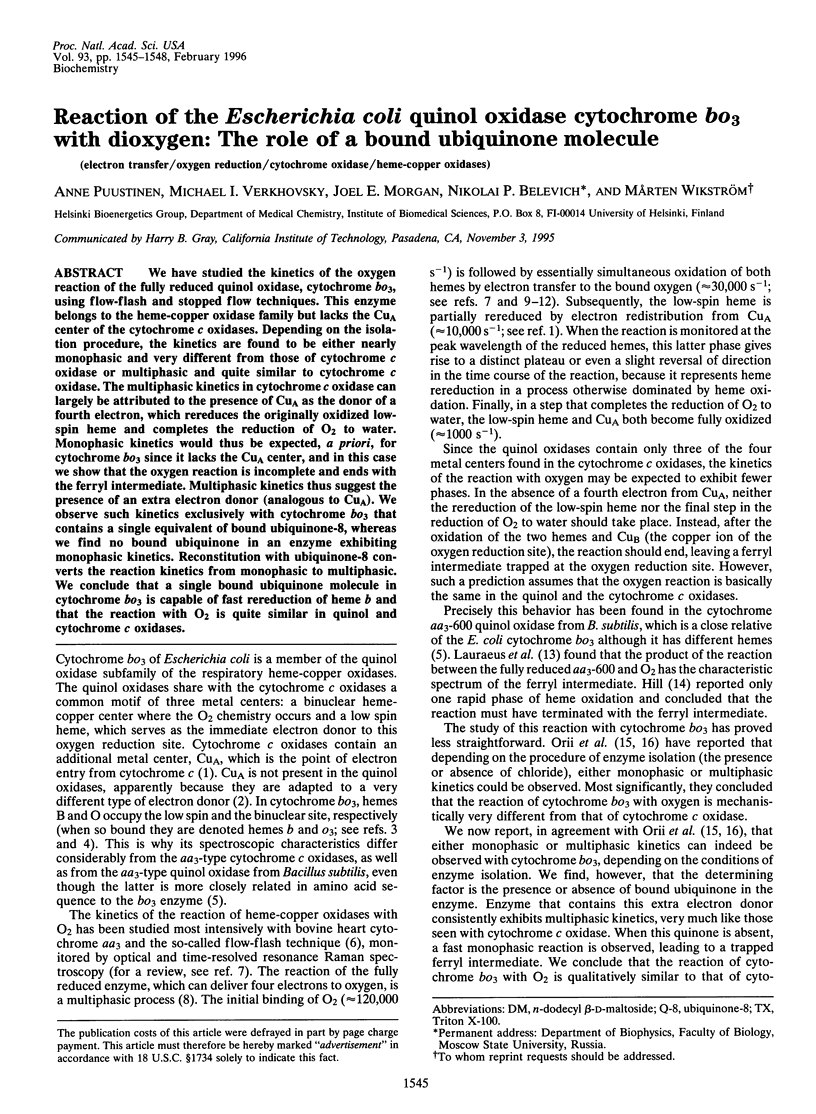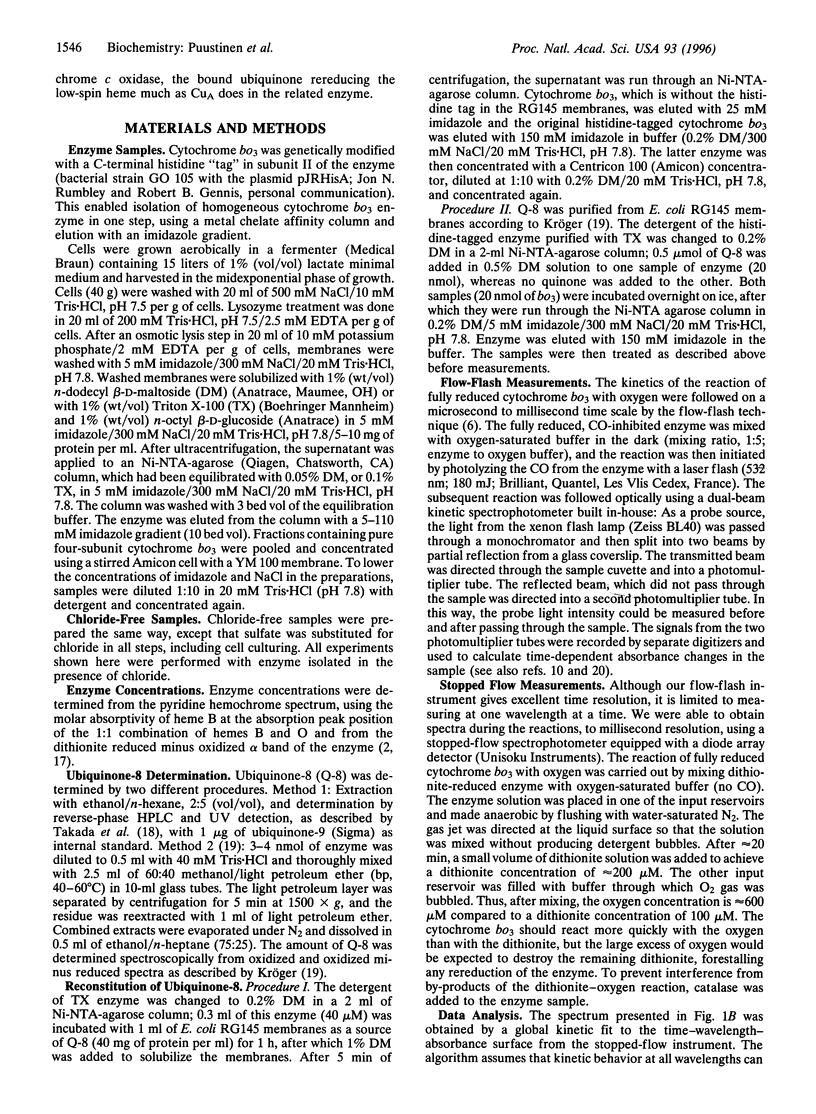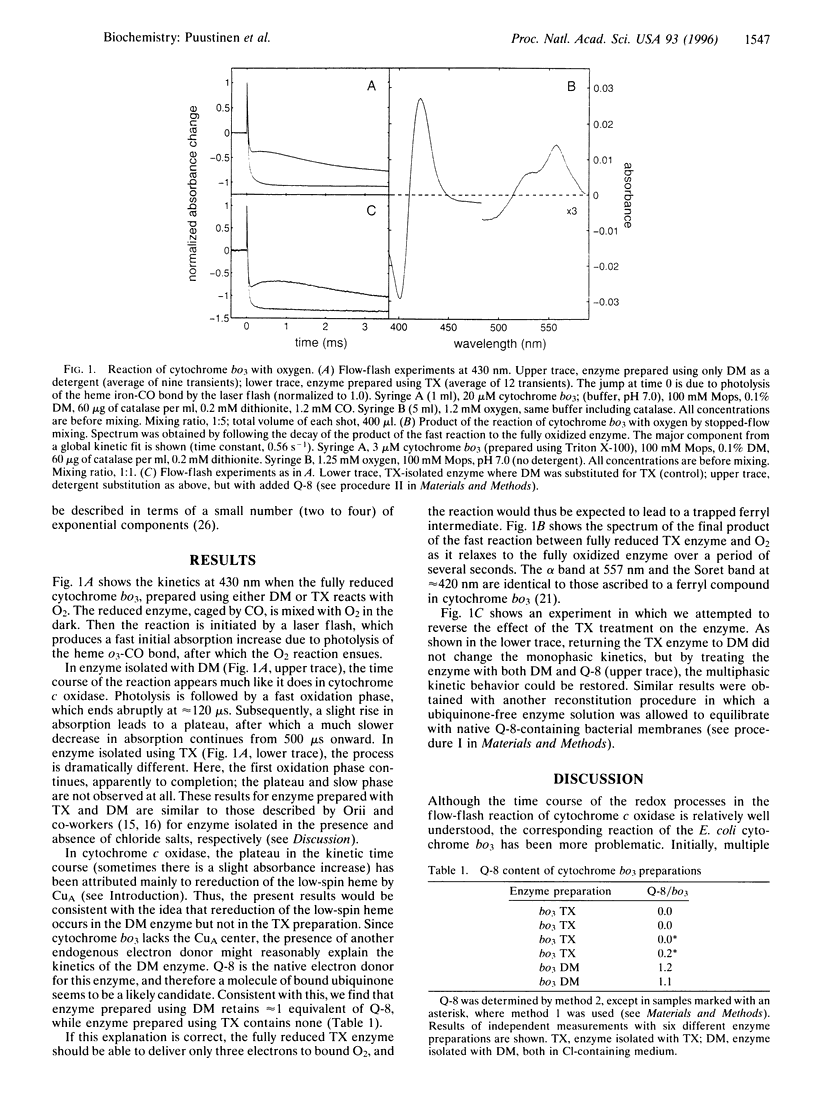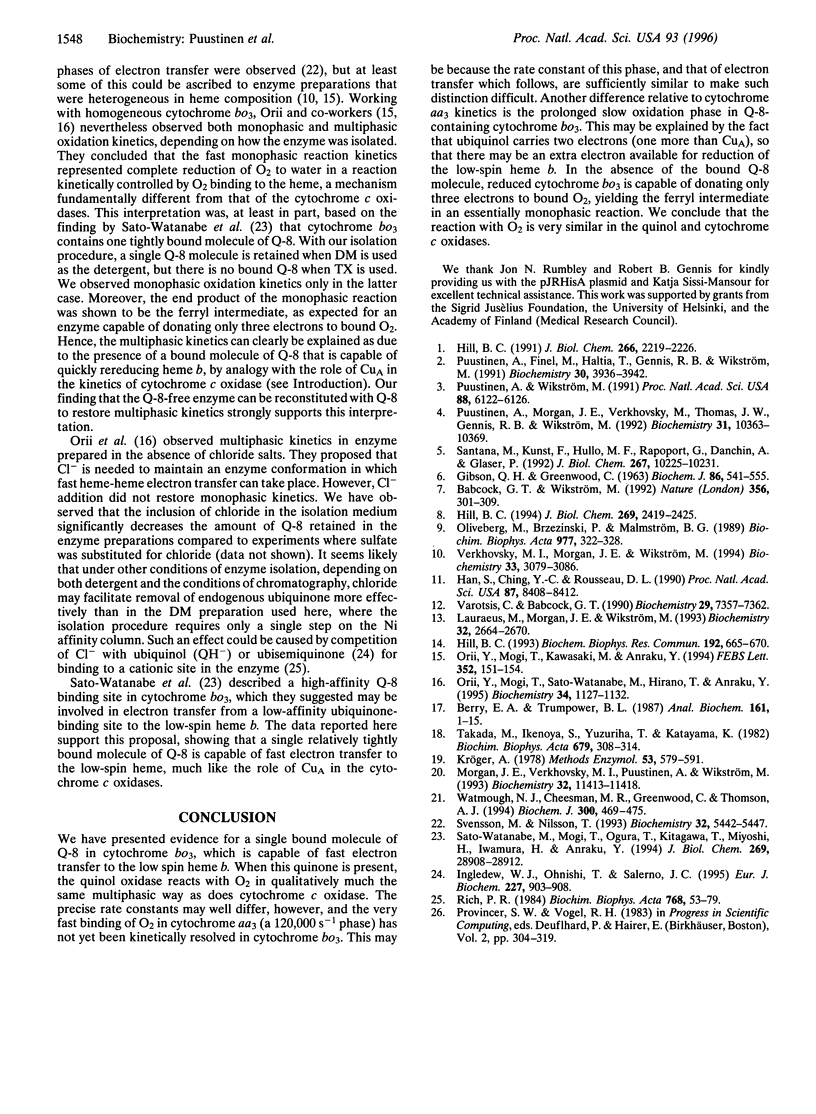Abstract
We have studied the kinetics of the oxygen reaction of the fully reduced quinol oxidase, cytochrome bo3, using flow-flash and stopped flow techniques. This enzyme belongs to the heme-copper oxidase family but lacks the CuA center of the cytochrome c oxidases. Depending on the isolation procedure, the kinetics are found to be either nearly monophasic and very different from those of cytochrome c oxidase or multiphasic and quite similar to cytochrome c oxidase. The multiphasic kinetics in cytochrome c oxidase can largely be attributed to the presence Of CuA as the donor of a fourth electron, which rereduces the originally oxidized low-spin heme and completes the reduction of O2 to water. Monophasic kinetics would thus be expected, a priori, for cytochrome bo3 since it lacks the CuA center, and in this case we show that the oxygen reaction is incomplete and ends with the ferryl intermediate. Multiphasic kinetics thus suggest the presence of an extra electron donor (analogous to CuA). We observe such kinetics exclusively with cytochrome bo3 that contains a single equivalent of bound ubiquinone-8, whereas we find no bound ubiquinone in an enzyme exhibiting monophasic kinetics. Reconstitution with ubiquinone-8 converts the reaction kinetics from monophasic to multiphasic. We conclude that a single bound ubiquinone molecule in cytochrome bo3 is capable of fast rereduction of heme b and that the reaction with O2 is quite similar in quinol and cytochrome c oxidases.
Full text
PDF



Selected References
These references are in PubMed. This may not be the complete list of references from this article.
- ATHERTON N. M., GIBSON Q. H., GREENWOOD C. Electronspin-resonance changes on oxidation of cytochrome oxidase. Biochem J. 1963 Mar;86:554–555. doi: 10.1042/bj0860554. [DOI] [PubMed] [Google Scholar]
- Babcock G. T., Wikström M. Oxygen activation and the conservation of energy in cell respiration. Nature. 1992 Mar 26;356(6367):301–309. doi: 10.1038/356301a0. [DOI] [PubMed] [Google Scholar]
- Berry E. A., Trumpower B. L. Simultaneous determination of hemes a, b, and c from pyridine hemochrome spectra. Anal Biochem. 1987 Feb 15;161(1):1–15. doi: 10.1016/0003-2697(87)90643-9. [DOI] [PubMed] [Google Scholar]
- Han S. H., Ching Y. C., Rousseau D. L. Cytochrome c oxidase: decay of the primary oxygen intermediate involves direct electron transfer from cytochrome a. Proc Natl Acad Sci U S A. 1990 Nov;87(21):8408–8412. doi: 10.1073/pnas.87.21.8408. [DOI] [PMC free article] [PubMed] [Google Scholar]
- Hill B. C. Modeling the sequence of electron transfer reactions in the single turnover of reduced, mammalian cytochrome c oxidase with oxygen. J Biol Chem. 1994 Jan 28;269(4):2419–2425. [PubMed] [Google Scholar]
- Hill B. C. The reaction of Bacillus subtilis aa3-600 oxidase with oxygen: an aa3-oxidase lacking the CuA site. Biochem Biophys Res Commun. 1993 Apr 30;192(2):665–670. doi: 10.1006/bbrc.1993.1466. [DOI] [PubMed] [Google Scholar]
- Hill B. C. The reaction of the electrostatic cytochrome c-cytochrome oxidase complex with oxygen. J Biol Chem. 1991 Feb 5;266(4):2219–2226. [PubMed] [Google Scholar]
- Ingledew W. J., Ohnishi T., Salerno J. C. Studies on a stabilisation of ubisemiquinone by Escherichia coli quinol oxidase, cytochrome bo. Eur J Biochem. 1995 Feb 1;227(3):903–908. doi: 10.1111/j.1432-1033.1995.tb20217.x. [DOI] [PubMed] [Google Scholar]
- Lauraeus M., Morgan J. E., Wikström M. Peroxy and ferryl intermediates of the quinol-oxidizing cytochrome aa3 from Bacillus subtilis. Biochemistry. 1993 Mar 16;32(10):2664–2670. doi: 10.1021/bi00061a026. [DOI] [PubMed] [Google Scholar]
- Morgan J. E., Verkhovsky M. I., Puustinen A., Wikström M. Intramolecular electron transfer in cytochrome o of Escherichia coli: events following the photolysis of fully and partially reduced CO-bound forms of the bo3 and oo3 enzymes. Biochemistry. 1993 Oct 26;32(42):11413–11418. doi: 10.1021/bi00093a019. [DOI] [PubMed] [Google Scholar]
- Oliveberg M., Brzezinski P., Malmström B. G. The effect of pH and temperature on the reaction of fully reduced and mixed-valence cytochrome c oxidase with dioxygen. Biochim Biophys Acta. 1989 Dec 7;977(3):322–328. doi: 10.1016/s0005-2728(89)80087-8. [DOI] [PubMed] [Google Scholar]
- Orii Y., Mogi T., Kawasaki M., Anraku Y. Facilitated intramolecular electron transfer in cytochrome bo-type ubiquinol oxidase initiated upon reaction of the fully reduced enzyme with dioxygen. FEBS Lett. 1994 Sep 26;352(2):151–154. doi: 10.1016/0014-5793(94)00939-2. [DOI] [PubMed] [Google Scholar]
- Orii Y., Mogi T., Sato-Watanabe M., Hirano T., Anraku Y. Facilitated intramolecular electron transfer in the Escherichia coli bo-type ubiquinol oxidase requires chloride. Biochemistry. 1995 Jan 31;34(4):1127–1132. doi: 10.1021/bi00004a004. [DOI] [PubMed] [Google Scholar]
- Puustinen A., Finel M., Haltia T., Gennis R. B., Wikström M. Properties of the two terminal oxidases of Escherichia coli. Biochemistry. 1991 Apr 23;30(16):3936–3942. doi: 10.1021/bi00230a019. [DOI] [PubMed] [Google Scholar]
- Puustinen A., Morgan J. E., Verkhovsky M., Thomas J. W., Gennis R. B., Wikström M. The low-spin heme site of cytochrome o from Escherichia coli is promiscuous with respect to heme type. Biochemistry. 1992 Oct 27;31(42):10363–10369. doi: 10.1021/bi00157a026. [DOI] [PubMed] [Google Scholar]
- Puustinen A., Wikström M. The heme groups of cytochrome o from Escherichia coli. Proc Natl Acad Sci U S A. 1991 Jul 15;88(14):6122–6126. doi: 10.1073/pnas.88.14.6122. [DOI] [PMC free article] [PubMed] [Google Scholar]
- Rich P. R. Electron and proton transfers through quinones and cytochrome bc complexes. Biochim Biophys Acta. 1984 Apr 9;768(1):53–79. doi: 10.1016/0304-4173(84)90007-7. [DOI] [PubMed] [Google Scholar]
- Santana M., Kunst F., Hullo M. F., Rapoport G., Danchin A., Glaser P. Molecular cloning, sequencing, and physiological characterization of the qox operon from Bacillus subtilis encoding the aa3-600 quinol oxidase. J Biol Chem. 1992 May 25;267(15):10225–10231. [PubMed] [Google Scholar]
- Sato-Watanabe M., Mogi T., Ogura T., Kitagawa T., Miyoshi H., Iwamura H., Anraku Y. Identification of a novel quinone-binding site in the cytochrome bo complex from Escherichia coli. J Biol Chem. 1994 Nov 18;269(46):28908–28912. [PubMed] [Google Scholar]
- Svensson M., Nilsson T. Flow-flash study of the reaction between cytochrome bo and oxygen. Biochemistry. 1993 May 25;32(20):5442–5447. doi: 10.1021/bi00071a021. [DOI] [PubMed] [Google Scholar]
- Takada M., Ikenoya S., Yuzuriha T., Katayama K. Studies on reduced and oxidized coenzyme Q (ubiquinones). II. The determination of oxidation-reduction levels of coenzyme Q in mitochondria, microsomes and plasma by high-performance liquid chromatography. Biochim Biophys Acta. 1982 Feb 17;679(2):308–314. doi: 10.1016/0005-2728(82)90301-2. [DOI] [PubMed] [Google Scholar]
- Varotsis C., Babcock G. T. Appearance of the v(FeIV = O) vibration from a ferryl-oxo intermediate in the cytochrome oxidase/dioxygen reaction. Biochemistry. 1990 Aug 14;29(32):7357–7362. doi: 10.1021/bi00484a001. [DOI] [PubMed] [Google Scholar]
- Verkhovsky M. I., Morgan J. E., Wikström M. Oxygen binding and activation: early steps in the reaction of oxygen with cytochrome c oxidase. Biochemistry. 1994 Mar 15;33(10):3079–3086. doi: 10.1021/bi00176a042. [DOI] [PubMed] [Google Scholar]
- Watmough N. J., Cheesman M. R., Greenwood C., Thomson A. J. Cytochrome bo from Escherichia coli: reaction of the oxidized enzyme with hydrogen peroxide. Biochem J. 1994 Jun 1;300(Pt 2):469–475. doi: 10.1042/bj3000469. [DOI] [PMC free article] [PubMed] [Google Scholar]


